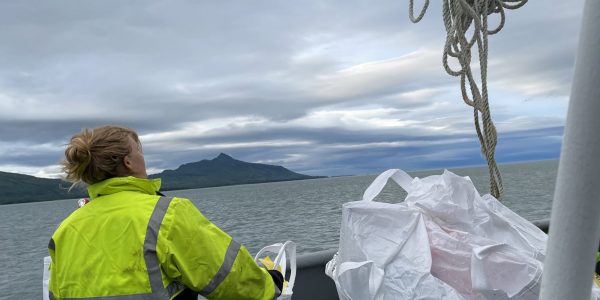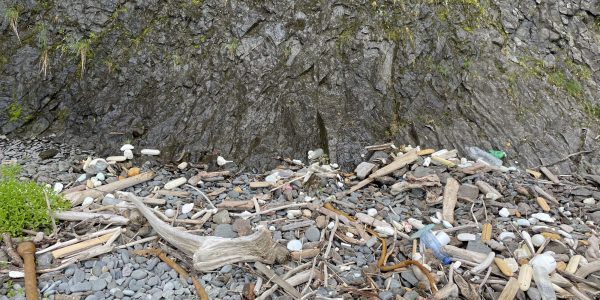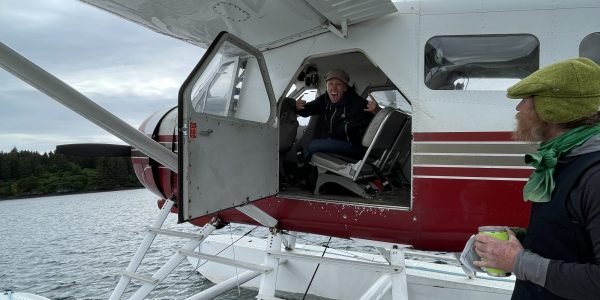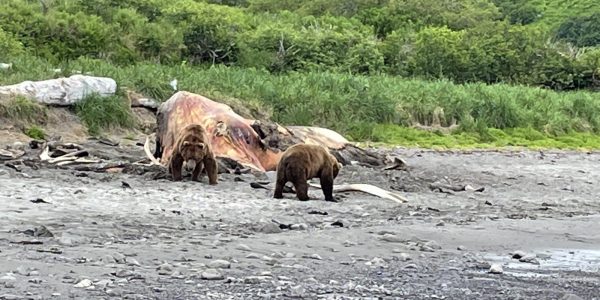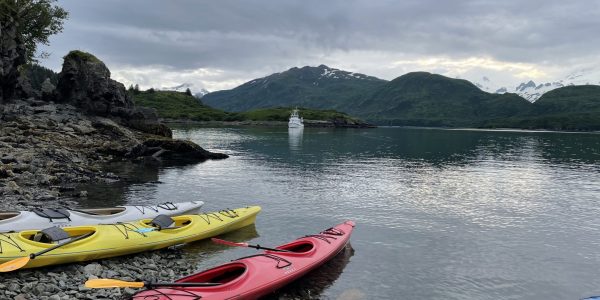Jackie and Ani Pick Up 8,500 lbs of Trash
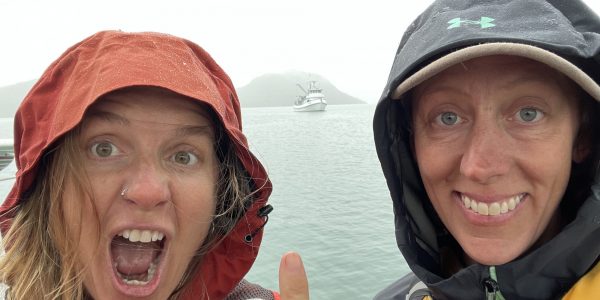
TEC staff participate in marine debris removal and recovery adventure in Alaska.
How do you say “no” to a once-in-a lifetime expedition adventure to one of the frontlines of the global ocean plastics crisis – the Alaska coastline? You don’t. When an invitation came from the Ocean Plastic Recovery (OPR) Project to join the Island C Research Vessel on an ocean cleanup project, Jackie and I (Ani) jumped right on that boat. Literally. With less than one week’s notice, we bought tickets, signed our volunteer waivers, threw together a presentation about The Environmental Center’s mission to share with fellow ocean waste pickers, and packed our mosquito nets in preparation for a trip to Katmai National Park, Alaska.
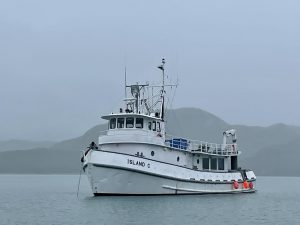 OPR was started by Portland-based former Oregon Green Schools board member, Scott Farling, and longtime Alaska boat captain, Andy Shroeder. OPR’s mission is: “To remove ocean plastics from the natural environment, to identify and develop reuse, recycling, and recovery alternatives for ocean plastics and to share what we learn with the global community.” Supported with a grant from National Oceanographic and Atmospheric Administration (NOAA), OPR brings aboard scientists, students, artists, and plastics recycling and recovery experts to be a part of the recovery team who will learn first-hand the full picture of ocean waste and its impact on our environment. This year they’ve already supported two trips and have a third on the calendar. Over these three tips, they will remove over 20,000 pounds of ocean debris from Katmai beaches.
OPR was started by Portland-based former Oregon Green Schools board member, Scott Farling, and longtime Alaska boat captain, Andy Shroeder. OPR’s mission is: “To remove ocean plastics from the natural environment, to identify and develop reuse, recycling, and recovery alternatives for ocean plastics and to share what we learn with the global community.” Supported with a grant from National Oceanographic and Atmospheric Administration (NOAA), OPR brings aboard scientists, students, artists, and plastics recycling and recovery experts to be a part of the recovery team who will learn first-hand the full picture of ocean waste and its impact on our environment. This year they’ve already supported two trips and have a third on the calendar. Over these three tips, they will remove over 20,000 pounds of ocean debris from Katmai beaches.
Typical Clean-Up Day
After filling our bellies with unapologetically delicious breakfasts and hot coffee, the thirteen of us divided into two teams and were shuttled ashore via skiff to areas only accessible by boat. Our efforts focused on Northeast facing beaches which tend to collect the highest amount of debris because of prevailing currents in the area. The teams would stretch out on the beach picking up any debris that washed up: bottles and jugs, trolling balls, fenders, buoys, nets, Styrofoam cups, blocks, bits, and pieces; and lots of other debris littering the beaches. What about masks, you ask? Yes, we found masks.
- Loading line and super sacks onto the R/V Island C.
- Marine debris in its not-so-natural habitat.
- When you look closely, you find more and more bits and pieces.
We filled small bags with smaller debris which joined larger debris in giant 5′ 3″ super sacks which were shuttled aboard the Island C with an on-deck hydraulic crane. We spent about three total days on the beaches and accumulated about 8,500 pounds of marine debris. Two pieces of food for thought:
- We were on very remote beaches that were nowhere near any human settlement.
- Alaska alone has nearly 34,000 miles of shoreline.
Check out this short video showcasing an experience aboard the Island C picking up marine debris. (Credit: Max Romey)
Lunch and learning
Lunchtime allowed us not only time to recharge (hauling garbage around on a rocky shoreline is exhausting!), but also opportunities for learning through onboard presentations. Here’s a taste of our fellow passengers and the incredible work they do:
- Students from OSU College of Chemical, Biological, and Environmental Engineering shared the work they are doing with plastic polymers and pyrolysis (turning plastic polymers back into their original monomer form through intense heat). They will likely be involved in the research phase of OPR’s initiative to recycle ocean plastics.
- A phD student from OSU’s Harper Nanotoxicology Lab presented her findings on the effects of micro- and nano-plastics and leachate (water that contains chemical runoff) from tires on a freshwater invertebrate and a freshwater fish. Her findings show that tire leachate in particular has significant effects on those biological organisms.
- We were also joined by John Dorgan from the College of Engineering at Michigan State who shared his on polymers and plastic recycling.
- Jackie and Ani presented on TEC’s efforts on waste reduction and recovery education through our Youth Education programming and the Rethink Waste Project.
- Scott Farling shared an in depth description of how mechanical recycling works from curbside collection to bailing to sorting.
Post dinner fun
While I admit this Island C adventure was the most fun I’ve ever had picking up trash, we DID do have other entertaining post-work activities. Here’s a taste:
- Our first-ever seaplane ride!
- Wildlife viewing including humpback whales, sea otters, and PUFFINS.
- Bears. Four big ole brown bears chowing down on a stinky rotting whale carcass.
- Sea kayaking.
What’s the future of the collected marine debris?
OPR’s grant from NOAA is funding both recovery and research. The plan is to bring the marine debris from Katmai back to Portland where it will be sorted and analyzed by Scott Farling and possibly some OSU students. Scott will oversee the research efforts to develop sustainable reuse, recycling, and recovery solutions for ocean plastics.
What can I do?
OPR hopes that their research will impact other sources of recyclable plastics, including ocean-bound and post-consumer streams, and contribute to a reduction of plastic waste (and use) overall. As consumers, we can help by reducing our purchasing, buying recycled materials, and recycling correctly. Even though we live in the desert, our actions affect the ocean, too. Our local plastic waste can break down and harm local freshwater organisms in our Central Oregon streams and rivers. If you are interested in learning more or donating to the Ocean Plastics Recovery Project, please visit their site here.
